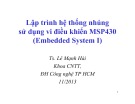
Embedded Software Engineering
EMBEDDED SOFTWARE
ARCHITECTURES
Graduate Course
ESE
Lecturers:
Dr. Nguyen Ngoc Binh
Dr. Le Quang Minh

ESE by NN Binh 2
Contents
•Round-Robin
•Function-Queue Scheduling
•Real-Time Operating Systems
•Selecting an Architecture

ESE by NN Binh 3
Software Architectures
•When you are designing embedded software, what
architecture will be the most appropriate for a given system?

ESE by NN Binh 4
Decision Factors
•The most important factor
–how much control you need to have over system
response.
•Good response
–Absolute response time requirements
–The speed of your microprocessor
–and the other processing requirements
•Few, loose reqts simple architecture
•Many, stringent reqts complex architecture

ESE by NN Binh 5
Some Examples
•The control of an air conditioner
–This system can be written with a very simple
software architecture.
–The response time can be within a number of tens
of seconds.
–The major function is to monitor the temperature
readings and turn on and off the air conditioner.
–A timer may be needed to provide the turn-on and
turn-off time.


















![Bài giảng Kiến trúc máy tính: Chương 1 - Giới thiệu tổng quan [chuẩn nhất]](https://cdn.tailieu.vn/images/document/thumbnail/2025/20250729/kimphuong1001/135x160/47331753774510.jpg)







